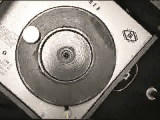
This bubble level acts like an accelerometer. Play the video below to see what you will need to do in class. Though difficult to see in the video, you will notice when you do it, that the bubble always points in a particular direction relative to the acceleration of the level. This only works while the level accelerates. We're not saying what that direction is right now, so you have to find out! If you prove to yourself that the relative position of the bubble can indicate the direction of acceleration, then you can use the bubble level to prove the direction of acceleration while the level spins at constant speed on a record turntable!

Mass the bubble level and record your information.
Accelerate the bubble by sliding it quickly in a straight line across your lab table. Do this several times. Notice the action of the bubble itself WHILE IT IS ACCELERATING. What position does the bubble take, relative to the direction of acceleration? Does this happen everytime? Try accelerating the level in different directions.
You will be placing the bubble level on the turntable. If your turntable is too slick, the level won't stay in place. If this is the case with your apparatus, fold a 6.0 cm piece of tape over on itself to make a double-sided loop and stick the level to the outer edge of the turntable.
Measure the radius of the level's circular from the center of the spindle to the center of your level. and record.
Set the turntable to 33 1/3 rps and start. Notice the direction the bubble points. What direction does the CENTRIPETAL ACCELERATION of the level take?
Calculate and report:
1. mass (m) in kilograms of the level,
2. radius (r) in meters of the circle,
3. The period of revolution (T) in seconds. Period is the time required to complete one full revolution. Hint: if there are 33 1/3 revolutions in one minute, how many minutes is that for one revolution, and how many seconds does that work out to? 331/3 rps is a frequency. Period and Frequency are mathematical inverses of each other.
4. The velocity (v) in m/s of the bubble in m/s as it goes around using the formula ![]() . In this and subsequent formulas, T is going to be in seconds, not seconds/revolution.
. In this and subsequent formulas, T is going to be in seconds, not seconds/revolution.
5. The centripetal acceleration (ac ) in m/s2 of the level using the formula.![]() AND
AND ![]()
6. The centripetal force (Fc) in Newtons on the level using the formula![]()
Each student turns in their results, showing all formulas and calculations, and with each result 'boxed in'.